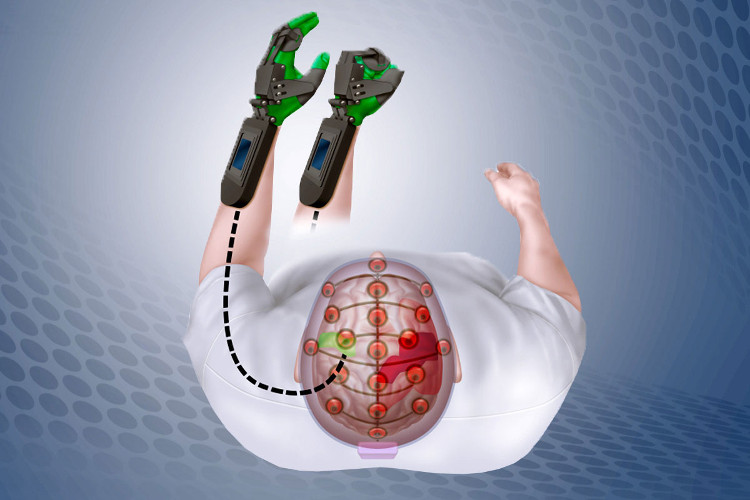Brain control device helps stroke patients move their limbs
Tens of thousands of stroke patients with disabilities are overwhelmed with new hope after scientists have demonstrated that the uninjured brain can be re-trained to move the paralyzed limbs.
Every year in the UK, about 100,000 people have a stroke and two-thirds of the 60,000 people who survive will leave the hospital with a disability.
Although many people are rehabilitated, often brain damage is so wide that this becomes difficult.
But now, American scientists have invented a device to re-train the damaged brain to continue to take on the tasks of the damaged part.

The device detects electrical signals in the undamaged part of the brain (green), and opens and closes a plastic brace fitted to the paralyzed hand (green).By doing so, it helps to re-train the non-injured areas of the brain to receive previous functions due to the injured area (red). (Photo: Sara Moser).
Professor Eric Leuthardt said: "We have shown that a brain-computer interface using the hemisphere without injury can achieve a meaningful recovery in chronic stroke patients."
In general, the left hemisphere controls the right side of the body and vice versa, but about a decade ago Professor Leuthardt and Dr. David Bundy discovered that a small area of the brain on the same side of the limb will send first 'motion' effect .
They hypothesized that if this initial signal could be mined and amplified, it could be used to control paralyzed limb motion.
The new device consists of a cap containing an electrode to pick up the signal of the brain and send it to a moving brace on the arm. The device will detect the person's thoughts, open or close the paralyzed hand, and move it accordingly. Over time, the brain begins to connect signals to hand movements and form new connections so that the motor process can occur without the brace anymore.

Dr. Jarod Roland tried the device to make his hand open and closed in response to brain signals - (Photo: Washington University Medical School).
The team selected 10 patients who were paralyzed six months after the stroke. They were invited to use the device for up to 2 hours a day for 12 weeks. At the end of the study, their ability to capture objects was better and the patient's motor scores increased by an average of 6.2 points on a 57 scale.
Professor Leuthardt rejoiced: "A 6-point increase shows a significant improvement in the quality of life. For some people, this represents the difference between being unable and able to dress yourself." .
The study was published in Stroke magazine.
- Inject germ cells into the brain to cure paralysis due to stroke
- Stickers to monitor stroke patients
- Device to diagnose stroke in 10 minutes
- Attach the chip to the brain to help people with polio move themselves
- Intelligent gloves help stroke patients recover
- Anti-clotting socks for stroke patients
- Stroke warning stroke
- Patients with paralysis can move with 'remote control'
- Decode the 'stroke shield' of the brain
- What to do to avoid disability after stroke?
- Video: People control other organisms brain
- Equipment to help prevent stroke
 Green tea cleans teeth better than mouthwash?
Green tea cleans teeth better than mouthwash? Death kiss: This is why you should not let anyone kiss your baby's lips
Death kiss: This is why you should not let anyone kiss your baby's lips What is salmonellosis?
What is salmonellosis? Caution should be exercised when using aloe vera through eating and drinking
Caution should be exercised when using aloe vera through eating and drinking Does exercising our minds a lot help us burn excess calories?
Does exercising our minds a lot help us burn excess calories?  How did Egyptian mummies remove the brain from the body?
How did Egyptian mummies remove the brain from the body?  Shocking evidence that near-death experiences are real in people who have had cardiac arrest
Shocking evidence that near-death experiences are real in people who have had cardiac arrest  AI has been able to accurately reproduce more than 80% of images in the human brain.
AI has been able to accurately reproduce more than 80% of images in the human brain.  Neuralink tests controlling a robotic arm with thoughts
Neuralink tests controlling a robotic arm with thoughts  Elon Musk's ambition to merge humans with AI
Elon Musk's ambition to merge humans with AI 